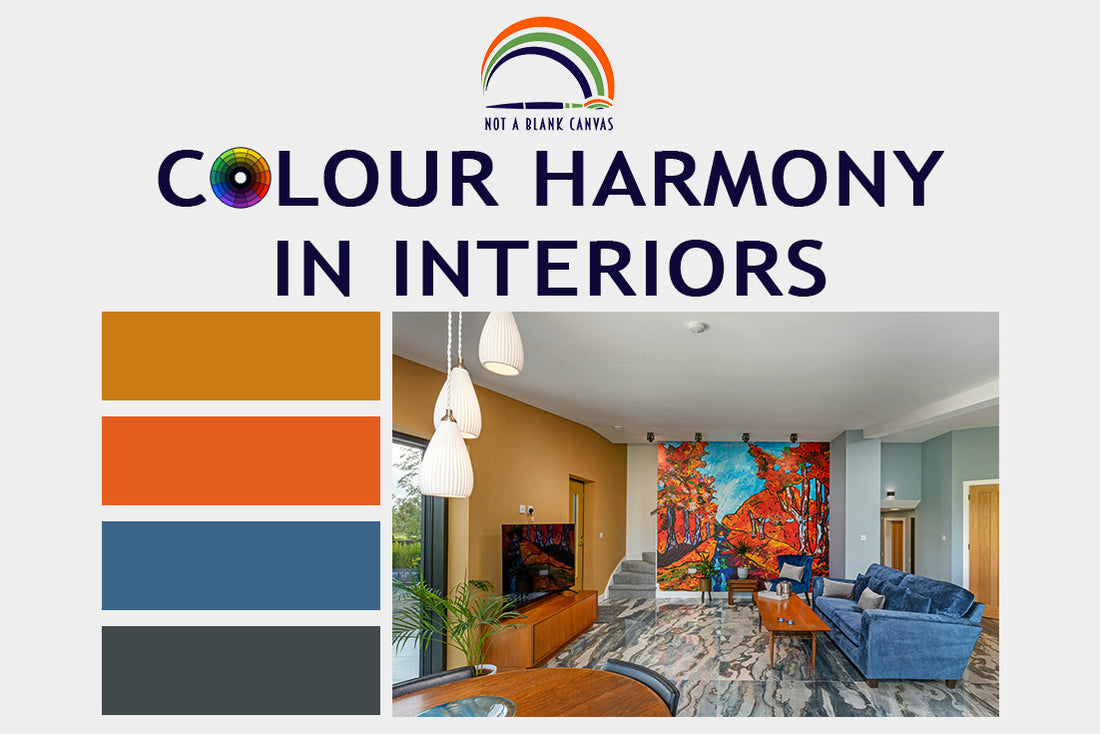
The Art of Colour Harmony in Interior Design
Share
Copyright Notice: The content on this blog, including text, images, and other media, is the intellectual property of Not A Blank Canvas unless otherwise stated. Unauthorised use and/or duplication of this material without express written permission from the author is strictly prohibited. Excerpts and links may be used, provided that full and clear credit is given to Not A Blank Canvas with appropriate and specific direction to the original content.
The Art of Colour Harmony: Transforming Your Living Space with Complementary, Analogous, Triadic and Other Colour Schemes
Colour is one of the most powerful tools in interior design. It has the ability to transform a space, evoke emotions, and create an atmosphere that truly reflects your personality. But selecting colours isn’t just about choosing shades you like—it’s about how those colours work together to create harmony in your living space. In this post, we’ll explore some popular colour harmony schemes—complementary, split complementary, analogous, quadratic, triadic, and monochromatic—and how you can use them to create a beautiful, cohesive interior.
The Colour Wheel
Before we begin, let's first take a look at our colour wheel since each colour harmony scheme will refer to different colours and their respective positions on this wheel:

Let's also not forget that when we talk about a colour, let's use orange as an example, that people tend to imagine the very saturated, pure bright orange. However, as we can see, orange is broken down into yellow-orange, orange and red-orange, and within each of those colour families we have varying tints, tones and shades.

What are tints, tones and shades? A tint is the pure, saturated colour we think of when someone says, for instance, orange, with white added into it, to create a paler, lighter colour. A shade is that same pure colour with black added to create a deeper, darker colour. A tone is the base colour with grey added in. Remember that grey is made up of black and white, so depending on the amounts of black vs white that went into the grey, we have many possibilities of different tones when mixed with our pure colour, known as the hue.
Why is this important? Because every aspect of the room contributes to colour harmony, not just the paint on the walls or the colour of the cushions, but the wooden furniture and the fixtures and fittings too. Take a look at the cover image above. Most people think of wood as brown, but really brown is just a darker shade of orange. This warm teak furniture works in this space alongside the blue-grey tiles as they fall into the complementary colour families of blue and orange.
1. Complementary Colour Scheme: High Contrast and Energy
A complementary colour scheme uses two colours that are directly opposite each other on the colour wheel, such as blue and orange, red and green, or yellow and purple. This scheme offers the highest contrast and makes both colours appear more vibrant.
How It Works in Your Living Area:

This red-green complementary scheme works all year round, giving warm and cosy vibes. Featured artwork: 'Into the Woods'.
2. Split Complementary Colour Scheme: Dynamic and Balanced
A split complementary colour scheme takes one base colour and pairs it with the two colours adjacent to its complementary colour. For example, if your base colour is blue, its complementary colour is orange, and the split complementary colours would be yellow-orange and red-orange. This scheme provides a high level of contrast while still maintaining harmony, making it more dynamic than an analogous scheme (which we'll come on to later).
How It Works in Your Living Area:
- Vibrant and Lively: If you love a space with energy and movement, a split complementary scheme might be for you. Imagine a room with a deep blue sofa, accented by orange and yellow cushions. The contrast between the blue and its complementary colours adds a pop of vibrancy, making the room feel lively and energetic.

From the blue-grey tiles to the warm wood, incorporating colour doesn't just come from wall paint and soft furnishings. Every element contributes to the colour scheme and should be balanced and cohesive. Featured artwork: 'Fiery Road'. Photograph used with permission from Finest Properties.
- Balanced Boldness: While split complementary schemes are bold, they can also be balanced. You can use a neutral colour (like grey) as the dominant hue and the split complements (green, pink and orange) as accents. This creates a dynamic yet harmonious space, perfect for a living room where you entertain guests and want to make a statement.

Whilst many may be tired of the all-grey approach, it can be a good anchor to those bold pops of colour, especially for those with more minimalist tastes. Featured artwork: 'Pink Canopy'.
- Depth and Dimension: This scheme can also add depth to a space. For example, a blue accent wall with orange and yellow artwork can create a sense of dimension, drawing the eye around the room and making the space feel more expansive.
3. Analogous Colour Scheme: Creating Calm and Cohesion
An analogous colour scheme uses colours that are next to each other on the colour wheel. For example, blue, blue-green, and green, or red, red-orange, and orange. This scheme is naturally harmonious and pleasing to the eye, as the colours blend smoothly into one another, creating a serene and cohesive look.
How It Works in Your Living Area:
- Serenity in the Living Room: Imagine a living room painted in soft shades of blue, teal, and green. The gentle transition between these colours creates a calming atmosphere, perfect for unwinding after a long day. This scheme works wonderfully in spaces where you want to promote relaxation, such as a living room or bedroom.
- Balancing Act: While analogous schemes are inherently harmonious, it’s essential to balance the colours to avoid a monotonous look. Use one colour as the dominant hue and the others as accents. For example, a teal wall with blue cushions and green plants can create depth and interest without overwhelming the space.
- Warm and Cosy: An analogous scheme with warm colours like red, orange, and yellow can make a space feel cosy and inviting. This works beautifully in a dining area, where the warmth of the colours can enhance the feeling of comfort and sociability.

For those who want a cohesive colour scheme, here's 'Gillfield Woods in Winter' forming the basis of this analogous living room.
4. Quadratic Colour Scheme: Rich and Complex
A quadratic colour scheme, also known as a tetradic colour scheme, involves four colours arranged in two complementary pairs. For example, you might pair blue with orange and green with red. This scheme is rich and complex, offering a lot of variety while still maintaining harmony.
How It Works in Your Living Area:
- Dynamic and Versatile: A quadratic scheme provides a wide range of colour possibilities, making it ideal for those who enjoy mixing and matching. For instance, a living room with a blue sofa, orange cushions, green plants, and red artwork can create a vibrant, eclectic look.
- Balanced Complexity: While the scheme is complex, it’s essential to balance the colours to avoid a chaotic feel. Typically, one colour is dominant, while the others serve as accents. This balance can bring a sophisticated and layered look to your space.
- Depth and Interest: Quadratic schemes can add depth and interest to any room. For example, using muted tones of each colour can create a subtle, harmonious environment, while brighter shades can energise a space and make it feel more dynamic.

When one colour just isn't enough! Featured artwork: 'Thistlewood'.
5. Triadic Colour Scheme: Bold and Balanced
A triadic colour scheme uses three colours that are evenly spaced around the colour wheel, such as red, yellow, and blue. This scheme is vibrant and provides a lot of contrast while still feeling balanced.
How It Works in Your Living Area:
- Bold and Playful: Triadic schemes are perfect for those who love colour and aren’t afraid to show it. In a living area, a red sofa, yellow cushions, and blue accents can create a playful, bold look that’s full of personality.
- Versatility: Triadic schemes can be adapted to suit any style, from traditional to contemporary. By adjusting the intensity of the colours, you can create a look that’s either bold and modern or soft and classic.
- Balanced and Dynamic: The key to a successful triadic scheme is balance. Use one colour as the dominant hue and the other two as accents. This will keep the scheme from feeling too chaotic while still allowing the colours to complement each other beautifully.

Red, blue and yellow doesn't have to scream primary school, unless you're into that über modern look! Here's a more pared down version featuring 'Like A Phoenix'.
6. Monochromatic Colour Scheme: Sophisticated and Understated
A monochromatic colour scheme uses variations in lightness and saturation of a single colour. This scheme creates a cohesive and sophisticated look, as the subtle variations in tone add depth and interest.
How It Works in Your Living Area:
- Elegant Simplicity: Monochromatic schemes are ideal for creating a serene and elegant space. Imagine a living room with various shades of grey—from light silver to deep charcoal—paired with different textures. This creates a sophisticated and calming atmosphere that is perfect for minimalist interiors.
- Depth Without Clutter: By sticking to one colour and its variations (it doesn't just have to be grey), you can add depth to your space without the risk of overwhelming it with too many colours. This is particularly effective in small spaces, where a monochromatic scheme can make the room feel larger and more open.
- Focus on Texture: In a monochromatic scheme, texture becomes key. Pair different materials—such as a velvet sofa with a wool rug and silk cushions—in similar tones to create a rich, layered look that’s full of character.

Don't forget, the monochromatic scheme works with any colour, not just shades of grey!
Bringing It All Together
Choosing a colour scheme is about more than just picking your favourite colours; it’s about how those colours interact to create a cohesive, harmonious look. Striking a balance is important. Did you notice that all these schemes take colours from both the cool and the warm side of the colour wheel? Whether you prefer the serenity of an analogous scheme or the dynamic contrast of a split complementary scheme, colour harmony can help you transform your living space into a place that feels just right.
Ready to bring colour harmony into your home? Whether you’re looking for original artwork, canvas prints, or custom wallpaper murals, explore the collection to find the perfect piece that complements your colour scheme. Let’s create a space that not only looks beautiful but feels like home. Ready to order a mural? Fill out the order form at the bottom of the page and I'll send you a proof and an invoice.
Want to learn more? If you want to learn more about deciding exactly which colours you should use in each room, check out my next blog entry on colour psychology - how different colours influence mood, emotions, and behaviours.
